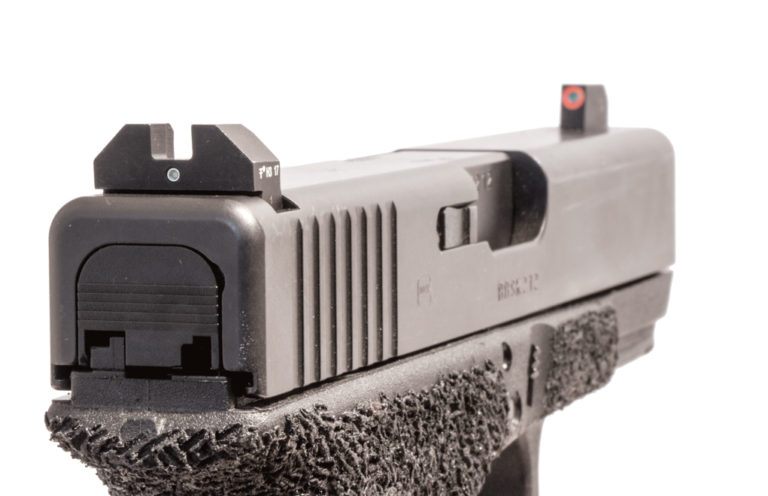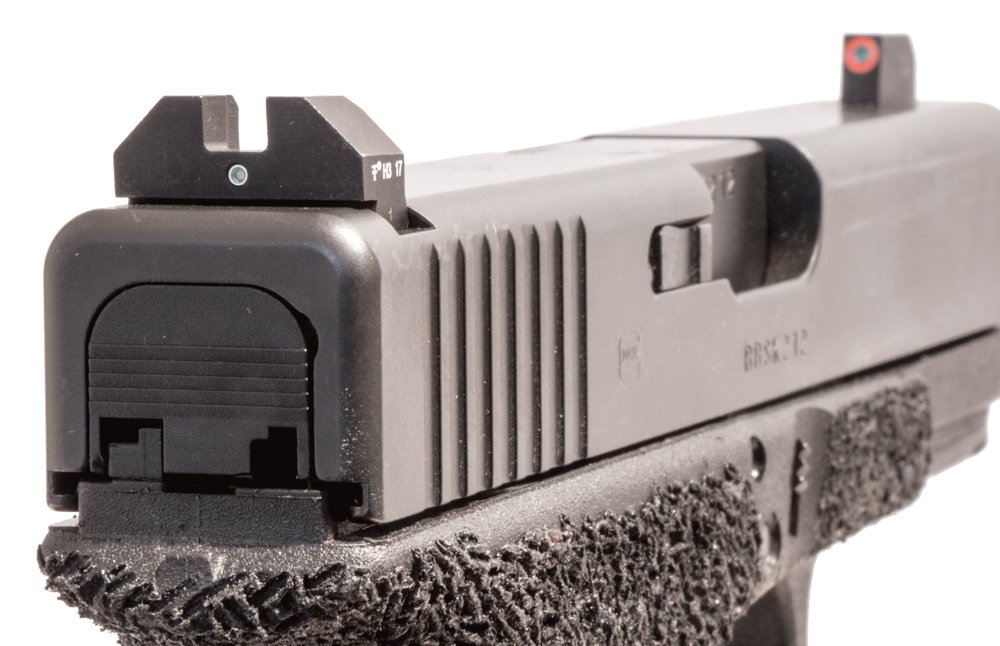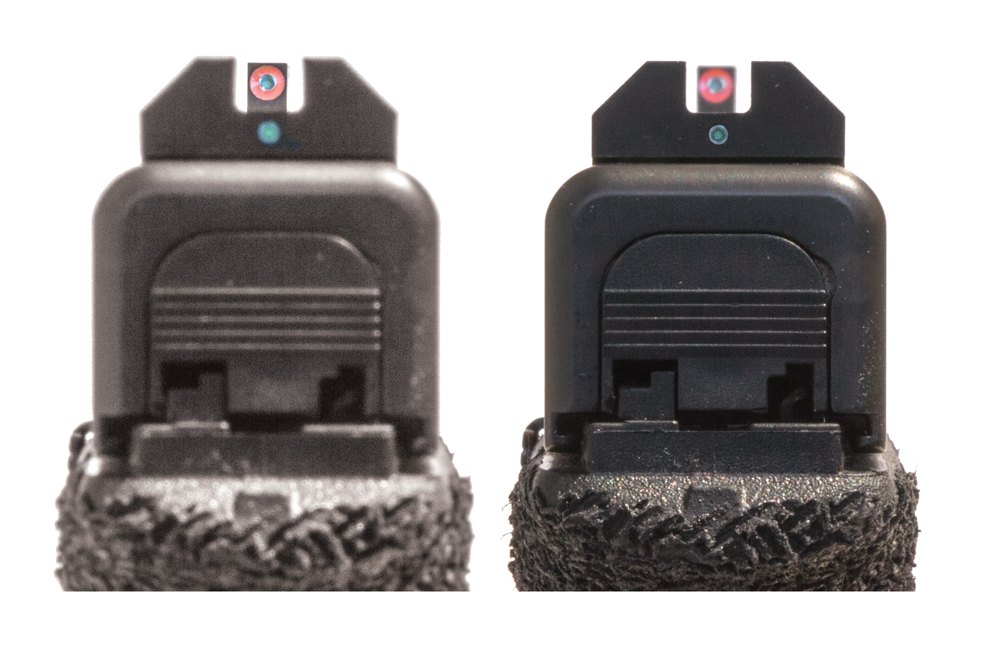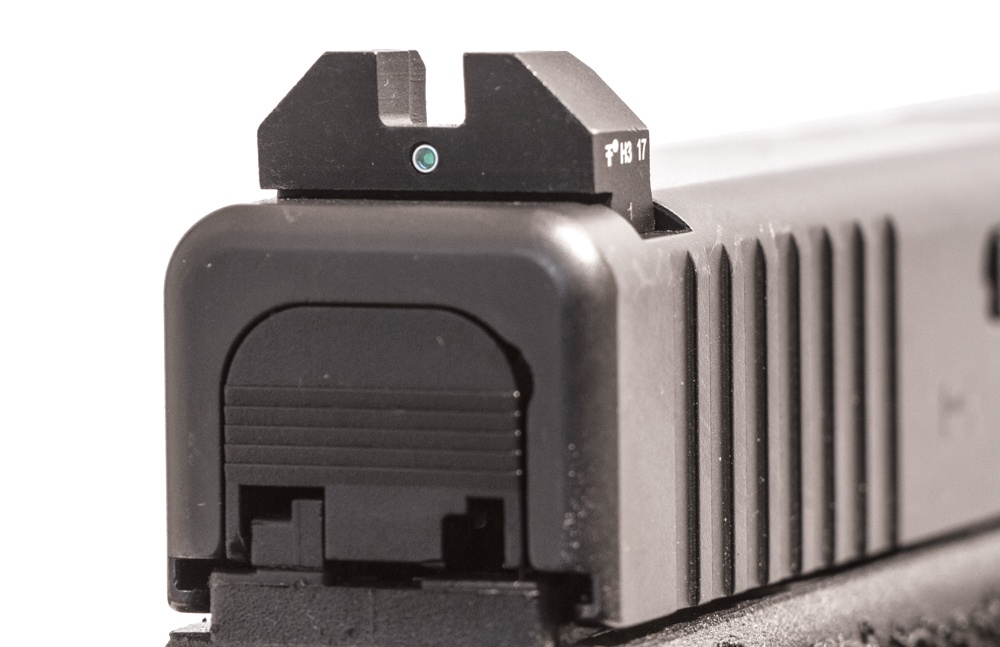
The new F8 sight from XS Sights puts you dead on target.
What the XS Sights F8 offers:
- F8 stands for “figure eight” — a term used to describe a two-dot sight.
- Each has a tritium vials, the rear under the notch.
- Orange paint sourrounds the vial on the front sight.
- The front post measures 0.160-inch wide.
- The rear notch in the rear sight that measures 0.190-inch wide.
After more than a hundred years, we’re finally seeing real advancements in iron sights for the defensive handgun. While the rest of the world has been focused on long-range optical sights that estimate distances and correct for bullet drop, XS Sights has been quietly working on engineering affordable sights to help citizens fight bad things. The new F8 sight from XS Sights might be the best thing you can put between you and a threat.

The handgun sight has evolved a great deal from its origin. On what might be the most iconic fighting pistol of all time — the Colt Single Action Army or Peacemaker — the front sight is nothing more than a thin blade. On the original 1911, another classic fighting iron, the front sight is barely a bump. Somewhere along the line, folks began to realize, to hit what you’re shooting at, you need to be able to see your sights.
The evolution began with the notch and post sight. It became a staple on Smith & Wesson revolvers, and it was liked so well that gunsmiths began fitting it to 1911s. For a long time, practical pistol competitions were the driving force behind better handgun sights, but eventually those who carried handguns in harm’s way began to realize that, sometimes — in certain conditions — target sights could be hard to see. Not only that, but sometimes when faced with a villain, just about any sight was hard to see because focus shifted to the threat.
With the inclusion of Tritium vials in handgun sights, the night sight was born. Eventually, this morphed into the three-dot night sight, with three tritium vials, one in the front sight and one on each side of the rear sight notch.

Tritium made sights easy to see in low light but helped little or none at all in normal conditions. One problem was the front sight was still small, and the notch you had to fit it into was small, too. The popular wedge-type sight pioneered by Wayne Novak was possibly the ultimate expression of — and most copied — three-dot sight.
The Big Dot Sight
A smart sheriff’s deputy from Texas created a better mousetrap. He realized those who hunt dangerous game face threats similar to those who might have to fight off an attacker with a handgun. The sights commonly used by dangerous game hunters had a large front sight that stood out like a pimple on the butt of a porn star, and a V-type rear blade.
Ashley Emerson designed the Big Dot sight to emulate the same sight a man on safari might use on a charging buffalo or lion. Working with an enterprising entrepreneur by the name of Ed Pastusek, they formed the company that’s now known as XS Sights.
The Big Dot sight has been my go-to sight for a long, long time. When I was hired as a special agent with the Railroad Police, I secretly installed them on my duty gun. This was more than 20 years ago, and I’ve been using them on defensive handguns ever since. Why? It was all because of a force-on-force training course. During the course, I was shoved in a semi-dark room with a pistol wearing traditional sights. I struggled to see the sights, missed the bad guy, and suffered an imaginary death.

Next, I was given a handgun outfitted with Big Dot sights. That big dot seemed to magically appear on the bad guy. When it did, multiple rounds of Simunition delivered to the same location immediately followed. In other words, I survived and painted the bad guy up rather nicely.
The beauty of the Big Dot sight is that you do not have to look for it: You see the big dot instantly, put it over the target and shoot. Their disadvantage — though mostly imagined — is that they do not allow precision shooting. I’ve never had this problem with Big Dot sights. In fact, when I took my first 250 Pistol Class at Gunsite Academy, I won the man-on-man shoot-off with a Para 1911 wearing Big Dot sights.
Others seem to have issues with the system, probably — mostly — because they simply do not practice enough. Regardless, XS Sights, which is now under the stewardship of Jon Pastusek, the late Ed Pastusek’s son, has created a new iron sight that’s sort of a hybrid cross between the company’s Big Dot sight and a traditional notch and post sight. If you threw a Big Dot Sight and a notch and post sight in a box, with a couple bottles of wine and some Sinatra music, the new XS Sights F8 sight is probably what would crawl out.
The F8 Sight
F8 stands for “figure eight,” which is a term used to describe a two-dot sight. A two-dot sight has a tritium vial in the front sight and another tritium vial centered under the notch in the rear sight. With three dot sights, you line the front dot up between the two rear dots. With a two-dot or figure eight sight, you simply place the front dot on top of the rear dot. It’s supposed to be faster and easier to align. Logically, this makes sense, but I have no idea how to definitively prove it.

Another feature of the F8 sight is its wide front post. Most commonly, defensive handgun front sights measure about 0.135-inch wide. The F8 front post measures 0.160-inch wide. The wide F8 front sight is paired with a notch in the rear sight that measures 0.190-inch wide. The result is a sight picture that’s fast to obtain because you have light, or space, between each side of the rear notch and each side of the front sight.
But, just like with a late-night infomercial, there’s more. The dot on the front sight contains a Tritium vial, but around that vial is a proprietary orange paint. The F8 front sight — orange dot — is only 0.020-inch smaller than the big white circle of a front sight on the XS Big Dot sight. The Tritium works great in low light, but the proprietary paint used for the orange dot seems to draw light like a railroad track draws winos. In daylight and in shade, this orange dot is like a beacon.
Testing The Theory
The goal of the F8 sight was to provide a multi-purpose defensive handgun sight that was easy to see in any light. It might be the easiest sight to see in any light and it is, unquestionably, a sight you don’t have to look for.
I mounted a set to a Glock 19 to see how well they worked. I ran that pistol and another Glock 19 with factory sights through my favorite defensive handgun drill, which is fired at 5 yards. I did this in daylight, evening and at night, five times with each pistol. For me, the F8 sight was 4 percent faster and more accurate. That might not sound like much, but in this business every little bit matters.
Another reason the F8 sights are faster and easier to see is because they’re taller than other sights. They’re not so tall they interfere with holster compatibility, but they’re tall enough they stand out. Have you ever noticed how the low front sight on a Glock can blend into the frame if your presentation is not spot-on? With the taller F8 sights, this is a non-issue. Your weapon presentation would have to be Hollywood-movie bad for you to not be able to instantly see the F8 front sight.
I’ve been a user of the XS Big Dot sights for a long time, and I never thought I’d want for anything different. Admittedly, I’m also a fan of the Wilson Combat Battlesight when it’s combined with a fiber optic front sight. The new F8 sight is, as far as I’m concerned, better than both. It’s the sight I’d much rather have between me and a bad guy, terrorist or even a werewolf.
Right now XS Sights is offering F8 sights for the Glock 17, 19, 20, 21, 22, 24, 26, 27, 30, 30S, 37, 41, 42 and 43. They’re also available for the Sig P320, P225, P226, P229; Springfield XD, XDm, XDs; and the FN 509. I’m sure that F8s for other handguns are soon to make their way to market. I’ll be patiently waiting for F8s to fit my 1911s and Browning Hi-Power.

Next Step: Get your FREE Printable Target Pack
Enhance your shooting precision with our 62 MOA Targets, perfect for rifles and handguns. Crafted in collaboration with Storm Tactical for accuracy and versatility.
Subscribe to the Gun Digest email newsletter and get your downloadable target pack sent straight to your inbox. Stay updated with the latest firearms info in the industry.

![Best Concealed Carry Guns In 2025 [Field Tested] Wilson Combat EDC X9S 1](https://gundigest.com/wp-content/uploads/Wilson-Combat-EDC-X9S-1-324x160.jpg)


![Best 9mm Carbine: Affordable PCCs [Tested] Ruger Carbine Shooting](https://gundigest.com/wp-content/uploads/Ruger-Carbine-Shooting-100x70.jpg)
![Best AR-15: Top Options Available Today [Field Tested] Harrington and Richardson PSA XM177E2 feature](https://gundigest.com/wp-content/uploads/Harrington-and-Richardson-PSA-XM177E2-feature-100x70.jpg)
